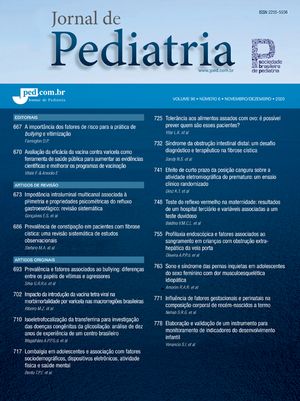
Although it is type 1 diabetes mellitus of autoimmune origin that is most prevalent in childhood and adolescence, other forms of diabetes can also affect this population, resulting in different prognosis and treatment.
SourcesInformation was obtained by means of a bibliographic review, carried out by running searches for scientific articles in the MEDLINE and LILACS databases, in addition to classic publications on the subject, with the most representative being chosen.
Summary of the findingsThis article discusses the pathophysiological mechanisms, clinical presentation and treatment of the various forms of diabetes that affect the pediatric age group, such as type 1 diabetes mellitus, type 2 diabetes mellitus, maturity-onset diabetes of youth, neonatal diabetes, mitochondrial diabetes, diabetes of generalized lipodystrophy, diabetes secondary to other pancreatic diseases, diabetes secondary to other endocrine diseases, diabetes associated with infections and cytotoxic drugs and diabetes related to certain genetic syndromes.
ConclusionsRecognition of the primary pathophysiologic mechanism of the form of diabetes presented can guide specific treatment, optimizing metabolic control and minimizing complications over the long term.
Apesar de o diabetes melito tipo 1 de origem autoimune ser o mais prevalente na infância e adolescência, outras formas de diabetes também podem acometer essa população, implicando em prognóstico e tratamentos diferentes.
Fontes dos dadosForam utilizadas informações através de revisão bibliográfica realizada por busca direta de artigos científicos nas bases de dados MEDLINE e LILACS, além de publicações clássicas referentes ao tema, sendo escolhidas as mais representativas.
Síntese dos dadosEste artigo discute os mecanismos fisiopatológicos, quadro clínico e tratamento das diversas formas de diabetes que acometem a faixa etária pediátrica, como diabetes melito tipo 1, diabetes melito tipo 2, diabetes do tipo maturity-onset diabetes of youth, diabetes neonatal, diabetes mitocondrial, diabetes da lipodistrofia generalizada, diabetes secundário a outras pancreatopatias, diabetes secundário a outras endocrinopatias, diabetes associado a infecções e drogas citotóxicas e diabetes relacionado a algumas síndromes genéticas.
ConclusãoO reconhecimento do mecanismo fisiopatológico primário da forma de diabetes apresentada pode orientar seu tratamento específico, otimizando seu controle metabólico e minimizando suas complicações a longo prazo.










